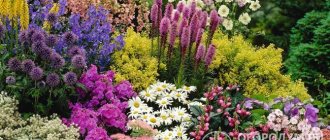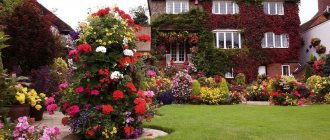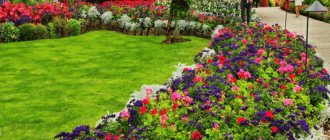Ampel plants, or ampels (derived from the German word die Ampel - a hanging flower vase) are ornamental crops grown in hanging pots and cache-pots. It is very easy to understand what ampelous means: such flowers have long, flexible stems that need support to grow in a given direction or go down in the form of a waterfall. In semi-ampeloid flowers, the shoots first stretch upward, forming a massive cap, and then begin to bend and hang down.
Features and advantages of hanging plants
A characteristic feature of the plants is a flexible stem that needs support: the flower curls upward along special nets or stands. If there is no support for the shoots, the pots are installed or suspended at the required height.
Flower wall made of ampelous Viola
Some plants are used as a ground cover crop, planted in open ground. However, this method does not reveal their true beauty.
The use of this type of plant is not limited. They are grown:
- as home interior decoration or on balconies;
- to create coziness in summer cottages by hanging flower pots near verandas and gazebos;
- in greenhouses, botanical gardens;
- for improvement of public places (parks, squares, train stations).
Advantages of growing hanging plants:
- Mobility. The issue of changing the location of the flower is resolved instantly: just move the pot to the right place.
- A variety of varieties to create picturesque compositions.
- Space saving. Flowers do not need to look for free space on the windowsill or shelf. When suspended, they will take up space, like a wall painting.
- Easy care in the form of regular watering and good lighting.
- Rapid growth and flowering throughout the warm season.
- Growing in urban environments. The lack of a summer cottage is not a reason to give up gardening: plants can be grown in pots on the balcony, giving it an unusual look.
Compositions
You don't need to be a designer to create a beautiful composition. The main thing is to choose the right varieties. Plants should complement each other. Compositions can be different: from a simple combination of different colors to professional selection. For example, you can plant yellow, red or orange petunias in one pot.
Composition of creeping
In general, hanging plants have many colors. The main thing to remember is that the plantings should be of the same height so as not to shade each other.
For a beautiful lawn, you can use low-growing and creeping ones. To do this, you need to plant the first ones in the middle, and the second ones along the edges. You can also place pots with different flowers around the perimeter of the site. Such oases will definitely become the property of the garden. Cascade compositions begin to be planted from the far row. Moreover, the longest plants are chosen for this, and the short ones are planted towards the end. This composition looks unusual if it combines flowering and non-flowering varieties.
Types of hanging plants
Among the variety of varieties, three groups of hanging plants are distinguished.
Succulents
Ampelous unpretentious perennial flowers for the garden
These include Rowley's ragwort, sedum, whip-shaped dysocactus, etc. These plants are valued for their hardiness and minimal care. The succulent shoots hanging from the pot are a heavy mass, so the flowerpot must be very stable or firmly fixed.
Important! Succulents love diffused light and humid air. They do not tolerate heat or excessive moisture.
Blooming
Representatives of this variety: fuchsia, aimenes, violet, etc. These are lovers of bright lighting, but not direct sunlight, heat, high humidity and regular watering.
The base of the roof of the house was decorated with flowering hanging plants - fuchsia
Decorative foliage
These include tradescantia, begonia, crested chlorophytum, etc. Shade-loving plants. For the bright color of the leaves they need fertile soil. Watering is carried out only after the soil has completely dried.
Summary
As you can see, you can create a garden design using hanging plants yourself. This will take some time, but the atmosphere that will reign later is indescribable. To make it easier to navigate plants, you can place a sign with a short description and care tips next to each individual species.
Recommended Posts
Perennial unpretentious flowers for the garden
Decorative border for flower beds
Perennial garden flowers
DIY outdoor flowerpots
Do-it-yourself flower beds at the dacha
Fountain in landscape design
What plants are suitable for hanging cultivation?
Ampel plants for home and balcony
Colorful, beautifully flowering plants with a large hat or long shoots falling from flowerpots are ideal for hanging cultivation.
Among the succulents, the most popular are:
- Sedum Morgana, or sedum. Growing is possible at home, in the garden. Fleshy cone-shaped leaves form massive lashes. Moisture accumulates inside the shoots, and therefore it tolerates drought well. This thrifty flower is suitable for busy people who are away from home for a long time. It blooms with small reddish flowers.
- Godson Rowley. People call it green pearl for its beady leaves strung on a thread - a thin stem. Flower growers grow ragwort both at home and in the open ground. Its stems reach up to 2 m. It blooms with white flowers, similar to dandelion, but the plant is valued for its foliage.
- Disocactus braided. A cactus with hanging spiny stems, reaching 1.5 m in length and 2 cm in thickness over five years of cultivation. In spring it blooms profusely with large pink tubular buds.
Flowering hanging plants have won the love of gardeners with their variety of colors, abundant flowering and unpretentious care.
- Fuchsia. The ampelous variety has thin stems that form a lush crown cascading down. Unusually shaped buds can have different colors.
- Aimenes. Perennial with a winter dormant period. The leaves are oval, pubescent. The buds are shaped like a funnel with five blades. Abundant and lush flowering with all the colors of the rainbow makes the plant a universal favorite.
- Violet, or viola. The flowers are similar to field pansies, only larger. Planted both in pots and in open ground.
Examples of decorative deciduous ampelous flowers:
- Tradescantia. It is a creeping, creeping shoot with oval leaves densely located on them. The color of the leaves is varied. There are varieties where one side is usually green, the other side is burgundy. Also some have white, pink stripes. Blooms with large white and pink flowers.
- Begonia. A flower with asymmetrical leaves and lush red blooms.
- Chlorophytum crested. The bush has long green leaves 3 cm wide with a white stripe in the middle. Shoots hang from the middle, on which daughter bushes are formed over time, overall representing an original cascade.
Tradescantia, thanks to its unusual colors, has not lost its popularity for a long time.
Decorative foliage ampels
This species includes plants with inconspicuous flowers or those that do not bloom. They do not have any decorative value. Such specimens are very numerous, they have quite unusual and interesting varieties.
Ivy
This vine is quite unpretentious and feels great even in dry air. It is used to decorate windows and walls; thanks to its dense growth, it successfully masks bare areas. It has leathery, shiny leaves. Variegated varieties of ivy are very finicky to care for. The plant is slightly poisonous, so it is advisable to limit access to it by animals and children. It is a climbing, shade-loving indoor flower.
Care methods:
- Ivy should be fed with fertilizers 2 times a month;
- Water in a timely manner and sufficiently well;
- To stimulate density and branching in the fall, it is necessary to cut the shoots to 1/3 of their length.
Wood's Ceropegia
This strange name for an ampel plant hides an attractive flower with variegated, round leaves and thin, long stems. The axils of the leaves form nodules that have a supply of moisture. The plant has its own peculiarity - beautiful interlacing of stems. If you try to untangle them, you may damage the ceropegium. Plant several shoots of the “green friend” in one pot and get dense seedlings.
Rules of care:
- A hanging plant pot is well suited for such an interesting specimen. Then the branches will not break;
- A bright room with bright sunlight will be highly appreciated by a “green resident”;
- It will grow well on a frame. Also, with the help of ceropegia, various figures are made;
- This representative of the flora belongs to succulents, so excess moisture is destructive for it, and lack of humidity is an ideal condition for growth.
Read this article on how to grow ceropegia at home.
Choosing hanging plants for the garden
What are gerbera flowers - what they look like and how they grow
An ampelous flower is a plant that can be used to decorate a veranda, gazebo, or fence. Planted tubs of flowers along the terraces will look good. An inconspicuous wall can be decorated with vines of climbing plants planted in the ground, having previously set the directions with tied ropes.
Interesting! You can use vines to form a metal arch, which will serve as a guiding support for the flower.
You can decorate antique things with hanging flowers, giving them a second chance at life. For the designer there is no question what this means - hanging, he understands that such plants can be used to decorate a broken bicycle, a kettle, a small cart, or a wheel.
What a curiosity
Everyone comes across hanging plants in everyday life, but perhaps is not aware that they are called that. The word ampel itself, from which the name of the plants comes, has German roots. It can be translated into Russian using meanings such as “vase” or “pot”.
It follows from this that initially ampelous plants were those grown in pots. This applies to a greater extent to those that are not grown indoors. All types can be divided into groups depending on the type of growth:
- curly;
- creeping.
Climbing versions of hanging plants are used on various vertical surfaces. Fixation occurs due to multiple tendrils or aerial roots. In this case, the plant completely encircles the territory provided to it, covering it with beautiful flowers.
Curly options are often used to decorate all kinds of arches, which perfectly replace artificial canopies in the hot season. In addition to those plants that weave the surface from bottom to top, there are also cascading options. In this case, they cover the structure with a carpet. Most types of these plants are planted in pots that are located on a hill.
Creeping ampelous plants can be used along with climbing ones. They will perfectly complement the horizontal surface. Thanks to its root system, the plant forms a carpet. Climbing hanging plants have flowering varieties and those that will delight you with green foliage. The latter can be used in conjunction with flowering ones to create a complete picture.
Note! For climbing varieties of hanging plants, you will need to pull additional guides in the form of threads or ropes, which will allow you to set the direction of growth. If you don't do this, the end result will be beautiful in its own way, but a little messy.
What varieties of hanging trees are best to plant on the site?
On the plots, ampelous annual plants are most often planted. A short list of the most used ones:
- Petunias. The importance of these cultures is difficult to overestimate. When asked “what are hanging plants,” these are the flowers that come to mind first. Petunias are used to build gorgeous cascades, balls, and decorate vertical surfaces. Her flowers delight until the month of November.
- Lubelia. These hanging annuals love sun and abundant watering.
- Dichondra. Creeping bindweed plants with shoots up to 1.5 m long.
Petunia variety Strawberry with cream ampelous F1
The following are perennials:
- Pelargonium or geranium. It is ideal for busy people because it tolerates drought well.
- Begonia. A fastidious flower, the complete opposite of geranium. Requires careful care and does not tolerate heat.
- Strawberries and strawberries. These crops have a hanging variety, which is popular with experienced gardeners.
Flower vases can be easily moved to another place, thereby updating the appearance of the garden. Using this method of arrangement, you can significantly transform any corner of the site.
Decorating the site with “bells”: Nolan flower in the design of the territory
Hanging nolana flowers can be a wonderful decoration for a personal plot. This plant appeared on home gardens not long ago, but the demand for it is constantly increasing, since the plant has both high decorative qualities and good resistance to changes in humidity, temperature, and strong winds.
Nolan - “bell”. Indeed, in this hanging plant, the flower stalks resemble bells in shape and color. Small, up to 5 cm in diameter, with carved edges, the flowers come in blue, light blue and violet shades. During the flowering period, nolana produces a pleasant aroma. The leaves are green and succulent, which allows the plant to survive in conditions of significant drought. The flowering period is quite long - from mid-June until the onset of sub-zero temperatures. The stems are creeping, one plant can cover an area of up to 1 m².
On the Internet in the photo, ampelous Nolan flowers are presented in several types: blue inflorescences with a yellow center, blue with a yellow core and white pharynx, purple with small white splashes along the pistil.
It is worth noting that this flower has a tap root system that practically does not branch out to the sides. This must be taken into account when choosing a container for planting.
Hanging nolana flowers can decorate any garden plot.
How to grow hanging plants
A simple way is to purchase ready-made flowers in a specialized store. All that remains is to choose a pot, place the plants there and arrange them in the right places on the site.
It is much more difficult to grow a crop from seeds, because it is not known what varieties will be obtained in the end and whether they will be combined with each other. Therefore, the seeds are planted in separate containers. Stronger plants are transplanted to a permanent place according to their preferences for the composition of the soil and its properties.
Determining the required soil is possible using the label on the seed package. The universal substrate for ampels is a combination of soil and peat 1:1.
Important! If there is a possibility of vegetative propagation of this type of plant, then you should not neglect it. It is the simplest and most effective.
Rules of care
Potted plants grown in pots require frequent watering, unlike those planted in the ground. The smaller the container, the more often the flower requires abundant watering. The soil must be equipped with drainage.
Lighting depends on the type of plant: light-loving or preferring to grow in a shaded area.
It is difficult for a plant whose stems hang a considerable distance from the pot to withstand the load. You can help the flower with the help of supports in the form of nets, columns, stretched threads around which the stems will wrap. The main requirements for supports are their stability and invisibility, so as not to distract attention from the object being tied up.
The plant is supported by a mesh
Pruning of ampels is carried out for rejuvenating, sanitary and formative purposes. Slow-growing plants should not be pruned. Dry shoots and wilted flowers are removed from fast specimens. Forming is resorted to in order to give the flower the necessary shape.
How to make a composition of ampelous plants
To give the garden brightness and uniqueness, ampelous plants are planted in combination with other species. Flowering species are combined with each other, as well as with decorative foliage plants. For example, bright petunia looks great with verbena, red geranium with white petunia, fuchsia with lobelia.
Unusual landscape composition
Homemade hanging planters
Hanging flowers are beautiful in themselves, and in a decent frame they will also look original. You can make flower pots for the street or balcony with your own hands, using available materials that you can always find at home.
What can be made from:
- canister, plastic bottle - give the container the desired shape, paint it and hang it on a beautiful twine, twine, cord, plastic chain;
- rubber slippers and boots are very comfortable because they don’t need to be painted and can be changed annually;
- wicker or leather, bag, basket - hung on a fence or wall create a cozy home environment;
- tin can – a composition of painted cans can be placed on a vertical support, fence, or wall of an outbuilding;
- scraps of plastic pipes coated with good paint look stylish and expensive;
- small wooden boxes from a bedside table, chest of drawers;
- old chandelier, lampshade;
- kitchen utensils, for example, a colander, a kettle, a saucepan, a funnel;
- watering can, bucket.
Almost all ampels grown in pots can be brought indoors with the onset of cold weather, and they will delight you with flowering for a long time, and some varieties will survive until spring.
Plants for the balcony
Decorating a balcony or loggia in an apartment with flower pots is a great idea for creating a cozy place to relax from the bustle of the city. Plants are brought to the balcony in May, when the danger of frost has passed, and watered daily.
Important! Balcony boxes must be well secured or placed securely.
Which hanging flowers to choose for flowerpots
Indoor plant species are used for the interior. Before choosing them, you need to consider the location of the balcony:
- South and west sides. Characterized by good lighting and constant exposure to dry air. Preference is given to verbena and milkweed. All flowering plant species will also fit perfectly, for example, petunia, pelagonia, surfinia, multifloral jasmine.
- North side. A shady loggia is suitable for shade-loving decorative foliage plants, such as begonia, impatience, and fern.
- East side. There is a compromise between light and shadow, which means both sun-loving and shade-loving plants are suitable for growing.
Decorating a balcony with hanging flowers
Pots with begonia, lubelia, and ampelous verbena will withstand the excessively windy side, which means a certain endurance of these species.
Important! Plants classified as succulents are not allowed on the balcony. You should also not plant flowers with opposite preferences in the same box, because... caring for them is very different.
Plants for hanging pots
Indoor fuchsia and ampelous begonia are taken out of the apartment and hung on the balcony in the summer, maintaining the same care for them. Garden long-flowering annuals also do well outdoors: petunia, verbena, snapdragon, viola, nasturtium, scaevola.
A hanging vase is convenient because it can be moved from place to place, changing the look of the balcony. For single plantings in hanging pots or flowerpots, bacopa, diascia, and bidens are suitable.
Ampelous flowers are very convenient for growing in the garden or on the balcony. The main thing is to choose the right variety and provide it with the right conditions.











